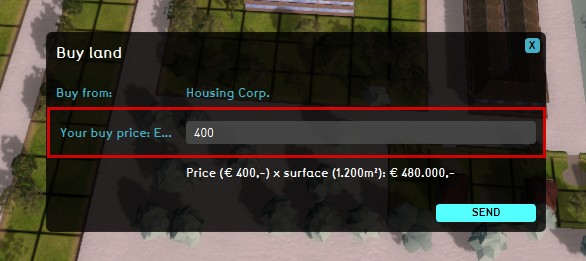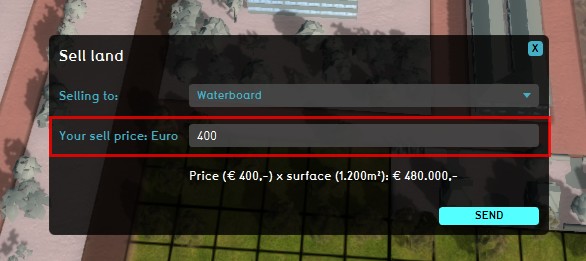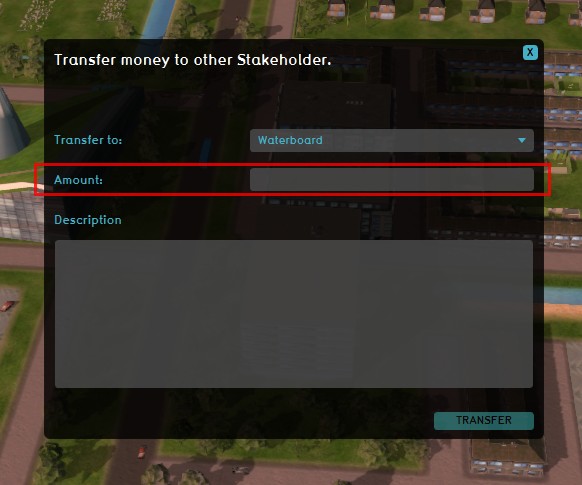Financial system: Difference between revisions
mNo edit summary |
mNo edit summary |
||
| Line 1: | Line 1: | ||
{{old style}} | |||
{{learned|file=FinanceLogo1.jpg|what a financial system is|what role the financial system plays in the Tygron Engine|about the elements of the financial system in the Tygron Engine|how to adjust the financial system in the Tygron Engine}} | {{learned|file=FinanceLogo1.jpg|what a financial system is|what role the financial system plays in the Tygron Engine|about the elements of the financial system in the Tygron Engine|how to adjust the financial system in the Tygron Engine}} | ||
Revision as of 07:14, 18 August 2015
Template:Old style Template:Learned
The Financial System in the Tygron Engine
In finance, the Financial System is the system that allows the transfer of money between savers (or investors) and borrowers.
The Financial System in the Tygron Engine handles all costs and income. It allows money transfers between the different stakeholders and the facilitator. Transfers can be executed between both playable and non-playable Stakeholders, where the facilitator can transfer money on behalf of the latter. This is useful, for example, as part of the negotiation process.
The system supports land transactions, the granting of subsidies and loans. It also takes extra costs, such as buy-out fees, into consideration when demolishing non-vacant structures. The Tygron Engine provides default values and calculations. However, by customizing these values, the system can be further tailored to a specific case by inserting financial data a user might have at his disposal.
Elements of the Financial System in the Tygron Engine
The financial system in the Tygron Engine consists of certain basic elements. These elements can be divided over two distinct groups: costs and income. The effect of these elements is depicted per stakeholder in their budget indicator.
Costs
In the Tygron Engine costs are generated as follows:
Construction costs
- Construction costs refer to the value of money that has been used up to build a construction in the Tygron Engine. Also the costs for terrain adjustments, such as lowering and raising the terrain, or changing the terrain behaviour, are referred to as Construction Costs.
Demolition costs
- Demolition costs refer to the value of money that has been used up to demolish an already existing construction in the Tygron Engine.
Land Price when buying
- The land price when buying reflect the purchase costs per measurement. This is a default value, however, this value is open for change during the negotiation process between the involved stakeholders.
Buy out costs
- When demolishing a construction in the Tygron Engine during game play, the associated costs can be considerable higher when the building is not vacant. These extra costs are the buy out fee that needs to be paid to the occupants for their relocation. In general it is cheaper to demolish vacant buildings, without the need for such a buy out fee.
Interest (loan costs)
- When a player is granted a (bank) loan, the calculated interest will be taken into account as costs. This is currently a fixed value in the Tygron Engine of an annual rate of 4%.
Money Transfers to other Stakeholders
- It is possible to transfer money to other stakeholders. This can happen, for example, as part of the negotiation process; one stakeholder performs an action that also positively affects an indicator for another stakeholder, who is willing to contribute to the project with an amount of money.
Income
In the Tygron Engine, income refers to the incoming money flow per stakeholder. Income can be generated from the following sources:
Income from constructions (rent)
- When a construction, such as an apartment block, is finished, the object will generate income for the owner. In order to calculate rental income, the total rent over an object during it's economical life span is added to the budget of the owner upon completion of the construction.
Land price when selling
- Selling an object will generate income in the form of sales income. Even extreme low price settings will generate income. This does not mean that the income generates profit automatically, as that depends on prior costs before the transaction. For example, selling a piece of land for a low price of 1 Euro per square meter, when previously a construction was demolished there for 10.000 Euro per square meter, will generate income, however, there will be a negative profit margin (loss) left over after the sale.
Subsidies
- Subsidies are a form of income where one party grants a sum of money to another party, often with special conditions. A municipality can grant a subsidy to a project developer for a certain project, under condition that the developer uses the subsidy to construct extra green roofs, parking lots, water storage, etc. Subsidies are considered regular income in the Tygron Engine.
(Bank) Loans
- A special form of income are (bank) loans. According to the definition, loans do increase the budget (= monetary consumption ability) available for the borrowing stakeholder. However, loans are subtracted from the lenders capital. In case the stakeholder has a bigger loan that actual capital, the stakeholder will not be able to score at all (in the total score). It is also worth considering that borrowing money costs money (interest), which is a cost (See also Interest (loan costs))
Money Transfers from other Stakeholders
- It is possible to receive a money transfer from other stakeholders. This can happen, for example, as part of the negotiation process; one stakeholder performs an action that also positively affects an indicator for another stakeholder. The acting stakeholder can receive a money transfer as contribution from the affected stakeholder.
Adjusting the Financial System in the Tygron Engine
In order to incorporate custom financial data, default values used in the Tygron Engine can be adjusted accordingly. Most of these values can be changed in the Function Value panel, which is located under the Indicators menu in the Editor. For more information about function values - for example how to add functions or add different categories to functions - see also the main article about functions. Template:Editor ribbon
Adjusting construction costs
The Construction Costs can be adjusted in the Function Value panel. These costs are displayed in an amount of money x 1,000/ surface unit. Currency and measurement units depend on the selected region (localization) of the game.
Adjusting demolition costs
The Demolition Costs can be adjusted in the Function Value panel. These costs are displayed in an amount of money x 1,000/ surface unit. Currency and measurement units depend on the selected region (localization) of the game.
Adjusting land price when buying
The Buy Price for land transactions has a default value of 400, whatever the currency unit is used. The actual adjusting of the price takes place in game, where the buying party can change this default value when proposing a transaction to another stakeholder.
- Open a game with land transactions available to the stakeholders
- Select 'Buy/ sell land' from the available actions on the left side of the screen.
- Select 'Buy land' from the action menu.
- Select the area to buy in the 3D world.
- Adjust the proposed Buy Price, if desired.
Adjusting buy out costs
The Buy Out fee are the costs involved with the relocation of inhabitants, when demolishing a structure that is not vacant. These costs can have a high impact on planned projects. Adjusting these costs can be done in the Function Value panel for each structure in the game.
Adjusting interest to be paid over (bank) loans
Currently the amount of interest is a fixed value in the Tygron Engine, which can not be adjusted. For simulation purposes of a planning game, the actual value is not that important. However, when there is demand for this value to be adjustable, this feature can easily be implemented in a future update.
Adjusting income generated by constructing
When a structure is constructed, an amount of money becomes available for the stakeholder that constructed it. This income is called the 'Sell Price' and can be adjusted in the Function value panel for each function. This 'Sell Price' also refers to the income generated on rental objects, such as constructions by housing corporations. The rent income is calculated over the economical lifespan of an object and the total is then added as one amount to the budget of the stakeholder upon completion of the project.
Adjusting land price when selling
The Sell Price for land transactions has a default value of 400, whatever the currency unit is used. The actual adjusting of the price takes place in game, where the selling party can change this default value when proposing a transaction to another stakeholder.
- Open a game with land transactions available to the stakeholders
- Select 'Buy/ sell land' from the available actions on the left side of the screen.
- Select 'Buy land' from the action menu.
- Select the area to sell in the 3D world
- Adjust the Sell Price, if desired
Adjusting subsidies
Requesting of subsidies, and the consequently adjusting of the amount of subsidy, takes place in game. This can only occur when the financial options to do so were implemented in the game. In case this option is available, follow the below steps:
- Open a game with financial options, such as Request Subsidy, is available to the stakeholders
- Select ´Financial Options´ from the available actions on the left side of the screen.
- Select ´Request Subsidy´ from the action menu.
- Select the stakeholder to request the subsidy from
- Select the amount of subsidy to request
Adjusting the amount of (bank) loans
Requesting a bank loan, and the consequently adjusting of the amount of the loan and period, takes place in game. This can only occur when the financial options to do so were implemented in the game. In case this option is available, follow the below steps:
- Open a game with financial options, such as 'Bank Loans', is available to the stakeholders
- Select ´Financial Options´ from the available actions on the left side of the screen.
- Select 'Bank Loans' from the action menu.
- Select the duration of the loan
- Select the amount of the loan request
Adjusting the amount of a Money Transfer
Adjusting the amount of a Money Transfer also only takes place during game play. This can only occur when the financial options to do so were implemented in the game. In case this option is available, follow the below steps:
- Open a game with financial options, such as 'Money Transfer', is available to the stakeholders
- Select ´Financial Options´ from the available actions on the left side of the screen.
- Select 'Money Transfer' from the action menu.
- Select the stakeholder to transfer the money to
- Select the amount of money to transfer



